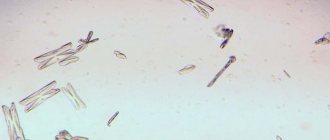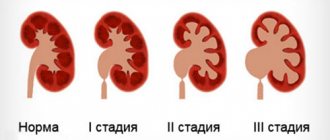To the reference book Complications of tonsillitis usually occur during the chronic course of the disease and are often accompanied by severe intoxication of the body
Author:
- Oganesyan Tigran Sergeevich
otolaryngologist, rhinosurgeon, leading physician of the clinic
(Voted by: )
- Tonsillitis
- Chronic
- In children
- Complications
- Treatment
The work of specialists at the Ear, Nose and Throat Clinic is aimed at treating diseases of the ENT organs. For accurate diagnosis, our medical center has modern equipment. It allows you to quickly identify the causative agent of the infection, which guarantees correct and effective treatment.
Complications of tonsillitis are often a consequence of advanced chronic tonsillitis. Under the influence of pathogenic factors, including allergic, bacteremic, etc., as well as due to disruption of the flow of neuro-reflex mechanisms, an imbalance occurs in the functioning of many systems.
Symptoms:
- red, swollen tonsils with white or yellowish coating or streaks;
- a sore throat;
- difficult and/or painful to swallow;
- fever (temperature above 38.0);
- cervical lymph nodes are enlarged;
- hoarse or hoarse voice;
- headache;
- stiff neck muscles;
- abdominal pain (especially in young children).
In infants:
- drooling due to pain in swallowing;
- anxiety;
- refusal to eat
- With chronic tonsillitis, your breath may smell bad.
Sources
- Corsino CB, Ali R, Linklater DR. Herpangina. 2021 Jun 23. In: StatPearls [Internet]. Treasure Island (FL): StatPearls Publishing; 2020 Jan–. PMID: 29939569. https://www.ncbi.nlm.nih.gov/books/NBK507792/
- Ter-Baghdasaryan L.V., Ratnikova L.I., Stenko E.A. Clinical and epidemiological aspects of enterovirus infection // Infectious diseases: news, opinions, training. 2021. Vol. 9, No. 1. pp. 88-93. doi: 10.33029/2305-3496-2020-9-1-88-93 https://infect-dis-journal.ru/ru/jarticles_infection/672.html?SSr=2601343bdb01ffffffff27c__07e4040b011a36-9772
- Alacheva Z. A., Rybalka O. B., Kulichenko T. V. Should everyone escape from Coxsackie?! Or fear has big eyes. Issues of modern pediatrics. 2017; 16 (4): 286–290. doi: 10.15690/vsp.v16i4.1774) https://vsp.spr-journal.ru/jour/article/viewFile/1787/713
- Herpangina Brenda L. Tesini. University of Rochester School of Medicine and Dentistry // MSD Handbook - 2019 https://www.msdmanuals.com/ru/professional/infectious-diseases/enteroviruses/herpangina
- Kozlovskaya O.V., Katanakhova L.L., Kamka N.N., Evseeva A.N. Epidemiological, clinical and diagnostic features of enterovirus infection in children and adults. Bulletin of Surgu State University. Medicine. 2018;(2):56-60. https://surgumed.elpub.ru/jour/article/view/140/141
- Kuo KC, Yeh YC, Huang YH, Chen IL, Lee CH. Understanding physician antibiotic prescribing behavior for children with enterovirus infection. PLoS One. 2021 Sep 7;13(9):e0202316. doi: 10.1371/journal.pone.0202316. PMID: 30192893; PMCID: PMC6128467. https://pubmed.ncbi.nlm.nih.gov/30192893/
- Instructions for use of the drug HEXORAL® SOLUTION:
- Instructions for use of the drug HEXORAL® AEROSOL:
- Instructions for use of the drug HEXORAL® TABS:
- Instructions for use of the drug HEXORAL® TABS EXTRA:
Up to contents
When to go to the doctor?
With sore throat, it is often important to make the correct diagnosis. Therefore, take your child to the doctor if:
- he has a sore throat for more than 24-48 hours;
- he has difficulty swallowing;
- he is unusually lethargic or, conversely, restless.
Meet our otorhinolaryngologist (ENT doctor) - Levchenko Egor Olegovich
Call an ambulance if:
- the child cannot swallow;
- the child has difficulty breathing;
- The child is drooling.
Complications of tonsillitis
- Labored breathing.
- Sleep apnea (holding your breath during sleep).
- Spread of infection to the tissue near the tonsils (peritonsillitis), peritonsillar abscess - accumulation of pus behind the tonsil.
- Acute cervical lymphadenitis is inflammation of the cervical lymph nodes.
Streptococcal tonsillitis can cause complications such as:
- acute rheumatic fever, affecting the joints, heart and other organs;
- glomerulonephritis (inflammation of the kidneys, which can lead to serious consequences, including kidney failure).
Treatment with antibiotics significantly reduces the likelihood of complications after streptococcal sore throat.
Chronic tonsillitis and related diseases
About the article
89306
0
Regular issues of “RMZh” No. 7 dated 04/05/1999 p. 4
Category: Otorhinolaryngology
Authors: Ovchinnikov A.Yu. 1, Slavsky A.N. 2, Fetisov I.S. 3 1 Federal State Budgetary Educational Institution of Higher Education MGMSU named after. A.I. Evdokimov Ministry of Health of Russia, Moscow, Russia 2 State Budgetary Educational Institution of Higher Professional Education “First Moscow State Medical University named after I.M. Sechenov" of the Ministry of Health of Russia 3 MBU "CRH" of the Balashikha urban district
For quotation:
Ovchinnikov A.Yu., Slavsky A.N., Fetisov I.S. Chronic tonsillitis and related diseases. RMJ. 1999;7:4.
Currently, about 100 different diseases are known, largely due to chronic tonsillitis. The lack of a therapeutic effect or short-term remission in such diseases is often due to the fact that doctors do not take into account the pathology of the pharynx as a possible cause that provokes and maintains associated painful conditions in other organs and systems of the body.
The purpose of this publication is to draw the attention of practitioners to a fairly large number of diseases that develop against the background of pharyngeal pathology, but are often not considered in the context of this relationship. The changes in internal organs are most pronounced in the decompensated form of chronic tonsillitis. They are caused by the influence of neuro-reflex, bacteremic, toxicemic and allergic factors. An imbalance in the immune status is also determined - redistribution in the content of T- and B-lymphocytes and their subpopulations, the presence of circulating immune complexes, sensitization of granulocytes to bacterial allergens. Circulating antigen-antibody immune complexes have chemotoxic activity and increase the proteolytic ability of macrophage enzymes, which leads to lysis of tonsil tissue and denaturation of tissue proteins, which as a result acquire antigenic properties. Once in the blood, they cause the formation of autoantibodies. Thus, the palatine tonsils become a site of permanent delayed-type sensitization to the antigens of streptococcus and staphylococcus - microflora that most often grows in the lacunae of the palatine tonsils. The neuro-reflex mechanism of the influence of chronic tonsillitis on the formation of associated pathology is also described. A.M. Monaenkov was the first to discover and study the afferent connections of the palatine tonsils with the most important subcortical formations, in particular with the co-structures of the posterior section of the subtubercular region of the hypothalamus. It is these nerve structures that are involved in the regulation of natural active immunity, which determines the central determination of disturbances in immunological reactivity in chronic tonsillitis. It has been established that under the influence of the flow of afferent signals from the tonsillar region, the functional state of the nuclei of the subthalamic region is disrupted and adrenergic receptors of neurons are excited. This serves as a trigger for the development of disruption of autonomic synergism and subsequent chain disorganization of other nervous structures. Such disturbances of neurodynamic processes in certain subcortical and cortical parts of the brain are called a “tonsillogenic” neurodystrophic process and are assessed as an obligatory component in the pathogenesis of any metatonsillar lesions. It is also possible to have a toxic effect on the body during chronic inflammation of the tonsils due to the dissemination of toxins by the hematogenous or lymphogenous route. It is now known that, along with the well-studied and thoroughly described influence of chronic tonsillitis on the formation of pathology of the heart, joints and kidneys, there are a large number of other associated painful manifestations. Thus, chronic tonsillitis creates real preconditions for the development of dermatoses. This, in particular, is confirmed by the rather high frequency of detection of chronic tonsillitis in patients with psoriasis and the presence in them of a clear relationship between the activity of the clinical course of this disease and the exacerbation of chronic tonsillitis. Many researchers consider tonsillectomy one of the most important components of treatment for patients with psoriasis. Sanitation of the focus of chronic infection normalizes altered reactivity and reduces allergenicity of the body, eliminates the pathological reflex effect on the central nervous system. It is advisable to perform tonsillectomy in the earliest stages of development of dermatosis. Conservative treatment should not be abandoned, since isolated cases of exacerbation of psoriasis after tonsillectomy have been described. A positive result is manifested in stable remission or mitigation of the clinical picture of exacerbations. Neurodermatitis is often combined with chronic tonsillitis, which in this case quickly becomes widespread with frequent relapses complicated by pyoderma. Treatment of neurodermatitis without sanitation of the source of chronic infection is ineffective. Chronic tonsillitis plays a role in the occurrence and course of collagen diseases (systemic lupus erythematosus, scleroderma, hemorrhagic vasculitis, periarthritis nodosa, dermatomyositis, polyarthritis). A similar antigenic structure of some collagenoses and chronic tonsillitis has been proven; for example, hemorrhagic vasculitis and chronic tonsillitis have common antigens - B 27, Cw2, Cw6. Chronic tonsillitis can lead to eye diseases. Thus, tonsillogenic intoxication can significantly weaken the accommodative apparatus of the eye. Therefore, an important measure to prevent myopia is early sanitation of the source of chronic infection. Behcet's disease, which causes eye lesions, is also provoked by a focus of chronic streptococcal infection during tonsillitis. A combination of nonspecific lung diseases and pathology of the palatine tonsils is often noted. Thus, endogenous peribronchitis is provoked by inflammatory processes of the nose, paranasal sinuses and lymphoid pharyngeal ring. Sometimes chronic tonsillitis can contribute to the exacerbation of chronic pneumonia, and also lead to a more severe course of this disease. Pulmonologists note that timely sanitation of a focal infection in the palatine tonsils reduces the number of complications in chronic lung diseases by 2.3 times. The infectious-toxic mechanism of liver damage in chronic tonsillitis is described. The streptococcal toxin streptolysin O is capable of disrupting the process of oxidative phosphorylation in hepatocyte mitochondria. As a result, existing liver diseases worsen. Thus, with viral hepatitis A, severe and protracted forms are more often observed, and with viral hepatitis B there is a tendency for the process to become chronic. There are known cases of development of damage to the biliary system in chronic tonsillitis. Cerebral complications in chronic tonsillitis arise as a result of vascular-circulatory disorders and toxic effects from the source of inflammation. The course of cerebrovascular disorders and toxic-infectious encephalopathy occurs in the form of a chronic process or crises. In this case, there are several forms of hypothalamic syndrome. The most common form is the vegetative-vascular form, then the neuroendocrine-metabolic form, and the least common is the neurotrophic form. A constant and early symptom is cerebral vascular insufficiency due to damage to the cardiovascular system. Hypothalamic angioedema is manifested by a persistent decrease in peripheral blood pressure and signs of peripheral angioneurosis (Raynaud's syndrome). Possible manifestation of cerebral angioedema in the form of migraine or Meniere's syndrome. These paroxysms are superimposed on chronic cerebrovascular insufficiency and are clinically manifested by neurotic conditions. Such “neurasthenia” is accompanied by general weakness and increased fatigue during mental and physical stress. With functional insufficiency of the hypothalamus, patients become sensitive to adverse meteorological factors. Sometimes neuro-endocrine disorders occur: obesity or weight loss, loss of appetite, thirst, hyperhidrosis, menstrual irregularities, decreased sexual potency. Due to damage to the nuclear stem structures, paroxysms of loss of skeletal muscle tone appear. Smooth muscle tone also decreases. Stem disorders are a consequence of chronic circulatory insufficiency, toxic-infectious and autoallergic processes that occur during chronic tonsillitis. Hypoxia of the respiratory center is manifested by irresistible yawning at the slightest mental or physical fatigue. It has been proven that women suffer from such disorders more often, since their hypothalamus is subjected to greater physiological stress. Chronic tonsillitis aggravates the course of schizophrenia. As a result of autointoxication, the disease becomes progradient or malignant. In the early stages of development of chronic tonsillitis, there is a compensatory increase in the level of androgens and glucocorticoids. As the disease develops, there is a gradual depletion of the function of the adrenal cortex with all the ensuing consequences for the body. Focal infection in the palatine tonsils can lead to weakening of the islet tissue of the pancreas and the release of a proteolytic enzyme that destroys endogenous and exogenous insulin. As a result, chronic tonsillitis can contribute to the decompensation of carbohydrate metabolism disorders already existing in the body, leading to an increase in hyperglycemia and glycosuria. In turn, metabolic disorders in diabetes form favorable conditions for exacerbations of chronic tonsillitis. Sanitation of the pharyngeal source of infection improves carbohydrate metabolism, which confirms the pathogenetic relationship of these diseases. Some researchers believe that conservative treatment of tonsillitis with this combination is ineffective and a tonsillectomy is necessary after a year. Follow-up data indicate that in patients with diabetes mellitus, surgery contributes to stable compensation, and in some cases allows to reduce the dose of insulin. With chronic tonsillitis, the thyroid gland suffers. Most often, there is an increase in hormone-forming function. This disorder is associated with hyperstimulation of the thyroid gland by thyroid-stimulating hormone from the pituitary gland. The consequence of this will be an increase in the concentration of thyroxine in the blood. This process is explained by the effect of pathologically altered palatine tonsils on the hypothalamic-pituitary system. Another possible mechanism for damage to the thyroid gland is associated with disorders of the immune system. Thus, in individuals with a genetically determined predisposition to autoimmune thyroid diseases, diseases such as autoimmune Hashimoto's thyroiditis, subacute de Quervain's thyroiditis, Riedel's fibrous thyroiditis, and acute thyroiditis may occur. It has been noted that the severity of pathological changes in the thyroid gland depends on the duration of chronic tonsillitis and the frequency of its exacerbations. As a result of successful treatment of the pathology of the palatine tonsils, one can observe an improvement in the condition of the thyroid gland and normalization of its hormonal synthetic function. There is evidence of a high incidence of chronic tonsillitis in obesity, which may be due to damage to the ventromedial and ventrolateral nuclei of the hypothalamus. In the decompensated form of chronic tonsillitis in combination with obesity, there are significant disturbances in the hormonal status (decrease in the level of testosterone and follicle-stimulating hormone and increase in luteonizing hormone). Children with such disorders have clinical signs of delayed sexual development (adiposogenital dystrophy). Chronic tonsillitis aggravates changes in the hypothalamic-pituitary regulation of the testes and delays the onset of puberty. Modern studies have proven the pathogenetic role of tonsil apudocytes in the development of immunodeficiency states. In chronic tonsillitis, a threefold increase in cells of the APUD system is recorded, cells producing serotonin and somatostatin appear, and the number of mast cells increases. Such changes may also be one of the reasons for the development of pathological changes in other organs. It has been proven that chronic tonsillitis has an adverse effect on the formation of the reproductive system in girls. Exacerbation of chronic tonsillitis and the transition of its compensated to decompensated form are more often observed at the age of 8-10 years (adrenarche period) and 12-14 years (menarche period), i.e. during activation of the endocrine function of the pituitary-adrenal system (adrenarche) and the entire reproductive system (menarche). Our studies have shown the presence of a direct relationship between chronic tonsillitis, especially its decompensated form, and disorders in the reproductive system in women of fertile age. These changes are characterized by disruption of the production of hormones such as follicle-stimulating, luteinizing, luteotropic, somatotropic, adrenocorticotropic and thyroid-stimulating, the appearance of uterine bleeding, hypomenstrual syndrome and amenorrhea of central origin. Such disorders in patients with chronic tonsillitis can be considered a manifestation of hypothalamic-tonsillar syndrome. Damage to the hypothalamic region is indicated by characteristic changes in the electroencephalogram. Changes in hormonal levels can provoke diseases such as endometriosis, adenomatosis and uterine fibroids. With chronic tonsillitis, the development of pregnancy pathology is often observed, since it contributes to a significant decrease in the body's adaptive capabilities and is a predisposing factor for the formation of toxicosis. There is often a threat of early or late miscarriage or premature birth. Deviations of labor may develop, such as premature rupture of amniotic fluid, weakness of labor. Often chronic tonsillitis leads to hypogalactia due to hypothalamic-pituitary disorders. We believe that patients with combined pathology of the tonsils and reproductive system should be under constant medical supervision by an otolaryngologist and gynecologist. There is a tendency to normalize hormonal synthetic function and clinical signs of reproductive disorders as a result of successful treatment of chronic tonsillitis. Most patients with a decompensated form of chronic tonsillitis have abnormalities in the morphogram (intersex physique). A characteristic set of symptoms is disproportionate, inharmonious, asynchronous development. False acceleration syndrome often occurs, which can be considered a variant of sexual infantilism. All of the above allows us to conclude that patients with chronic tonsillitis form a large risk group for many severe somatic disorders and require increased attention from both an otolaryngologist and doctors of other specialties. Only such an integrated approach can reduce the number of complications in patients with chronic tonsillitis.
Content is licensed under a Creative Commons Attribution 4.0 International License.
Share the article on social networks
Recommend the article to your colleagues
Diagnosis of tonsillitis
- For tonsillitis, the doctor will examine the child's throat, as well as his ears and nose, where there may also be inflammation.
- The doctor will examine the child's skin, since streptococcal sore throat sometimes causes a specific rash. This is what is called “scarlet fever” - it is not some kind of separate disease, but a sign of damage to the body by streptococcus.
- The doctor will feel the cervical lymph nodes - as a rule, with tonsillitis they swell.
- The doctor will feel the spleen to distinguish a sore throat from mononucleosis, which also causes swollen lymph nodes.
- The streptococcal test is a simple and accurate way to distinguish streptococcal tonsillitis from viral tonsillitis. The doctor takes a scraping from the child’s throat and within 24-48 hours the result is ready.
- In some cases, a general blood test may be needed, the results of which can also indicate the viral or bacterial nature of the disease. It is usually taken if the streptococcal test is negative, but the course of the disease leaves the doctor in doubt.
About the clinic
Euromed Clinic is a multidisciplinary family clinic in the center of St. Petersburg.
- Calling a doctor to your home
- 24/7 therapist appointment
- Tests, ultrasound, x-ray
- Whole body diagnostics
- Hospital and surgery
- Vaccination
Find out more about the clinic
Treatment of tonsillitis
The child should be provided with:
- peace and the opportunity to sleep as much as he wants;
- Drink plenty of fluids to relieve sore throats and prevent dehydration;
- air humidification;
- a sore throat can be relieved by both warm drinks and cold ice cream, especially popsicles;
- for a sore throat, it helps to gargle with a solution of table salt and soda - a teaspoon of salt and a small pinch of soda per 250 ml of warm water;
- Children over 4 years old can be offered lozenges for sore throats. Do not give candy to small children - they may choke;
- do not smoke when your child is sick, avoid strong odors that irritate the throat;
- A sore throat and fever can be relieved by medications containing paracetamol and ibuprofen. Don't give children aspirin; in rare cases, it can cause deadly Reye's syndrome.
Confirmed bacterial tonsillitis (usually streptococcal tonsillitis) is treated with antibiotics. It is dangerous to interrupt or stop the course because it increases the likelihood of infection spreading to the joints, heart, kidneys and other organs. Continue taking antibiotics even if your symptoms are completely gone.
Causes of herpangina
Herpangina can be caused by about 70 serotypes of enteroviruses. Most often these are Coxsackie B, Coxsackie A17 viruses and enterovirus 711.
Since the only carrier of enteroviruses is humans, you can become infected through contact with a sick person or with a virus carrier who has no symptoms of the disease1. According to the literature, the number of virus carriers can be up to 46% of people2.
The virus is released into the external environment with feces and droplets of saliva. It is also contained in bubbles that appear in the patient’s throat. Enterovirus infections most often affect children, although the disease also occurs in adults5.
The patient or virus carrier excretes viruses from the upper respiratory tract within 3 weeks after infection, and with feces - up to 8 weeks. In the first two weeks, herpetic sore throat is most contagious1.
You can become infected in the following ways:
- through dirty hands, objects and food if they are exposed to the virus;
- drinking contaminated water from a reservoir;
- upon contact with a patient or virus carrier.
The herpangina virus is also transmitted transplacentally - from mother to fetus3.
Up to contents











